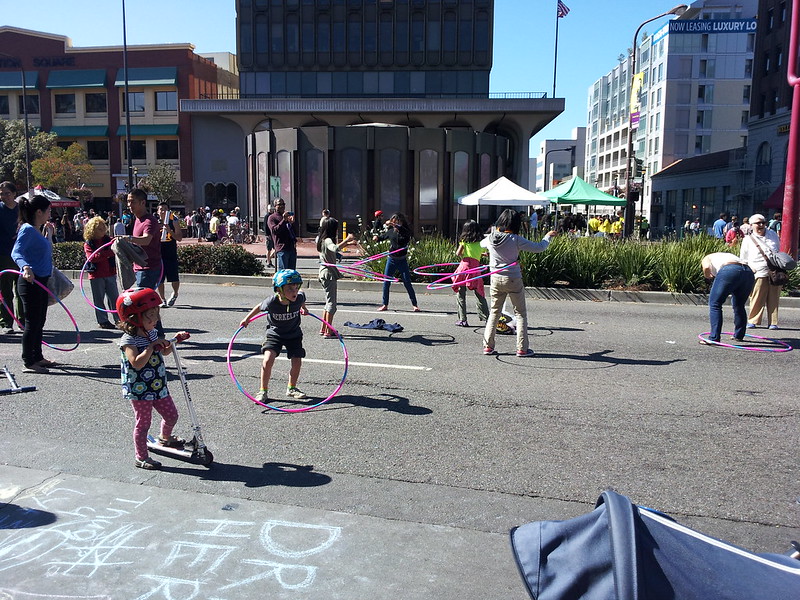In its second iteration, Sunday Streets Berkeley flooded Shattuck Avenue with an estimated 50,000 people last weekend in an even more powerful demonstration of the draw of closing streets to cars and opening them up to people.
Since the first event one year ago, political support seems to have only grown, and attendance once again exceeded expectations despite the challenges organizers continue to face in receiving financial support from the city.
"It really is a very important event now in Berkeley," said Mayor Tom Bates. "People all want to extend it to have it be more than once a year, and I would certainly be in favor of it."
Sunday Streets Berkeley received support from the City Council, which set aside nearly $60,000 to help finance one event for 2013 and another in 2014 (each event requires about $50,000 total). While some council members had initially expressed hesitance to approve those funds, the majority were apparently won over.
"There were lots of people with kids, which was wonderful to see," noted Berkeley Council Member Laurie Capitelli, who championed the city's grant to help support the program. "I really believe in the concept of Sunday Streets."
"Open streets don’t survive [without] the city -- the minimal level of support is that the city covers traffic, police, etc.," said Emunah Hauser, Sunday Streets director for Livable Berkeley.
John Caner, the chief executive officer of the Downtown Berkeley Association, remembers being "dumbfounded by the outpouring" when over 40,000 people turned out for the first event last October, where just 5,000 were expected. The Downtown Berkeley Association helped fund this year's event along with the North Shattuck Association.
As with the launch of Sunday Streets San Francisco in 2008, merchants who initially opposed the events based on fears that removing car traffic would hurt their businesses were quickly won over after witnessing the opposite result.
"That first year, we went a little bit out on a limb," said Caner, who said Hauser and other organizers with Livable Berkeley helped win over skeptics. "We didn’t hear any grumblings this year."
Hauser gives some credit to organizers of San Francisco's Sunday Streets for getting Berkeley's event off the ground. "We’re really grateful to them for all the knowledge base they shared with us," Hauser said.
The case for Sunday Streets was bolstered by a San Francisco study published earlier this year, which showed that the public health benefits of the city's open streets events outweigh the costs of organizing them.
At last weekend's event in Berkeley, over a mile of car-free Shattuck could be seen filled with activities like kids' bicycle rodeos, dodge ball, science demonstrations, storytellers, and a music class that filled the street with tiny tots happily whaling on drums.
Alta offered test rides of Bay Area Bike Share bikes, and the East Bay Bicycle Coalition showcased its current campaigns for bike-friendly streets at a crowded booth. Staff from goBerkeley, the city's new SFpark-style demand-based parking pricing program, set up a board where attendees to could place dots on a map to mark the best and worst places to bike and walk in the city.
"Getting the stories behind each one of those dots was very powerful," said Warren Logan, a goBerkeley intern, who noted that Sunday Streets offered a rare chance to poll so many people interested in bicycling and walking in one place.
Capitelli, the council member, said he'd like to see a Sunday Streets route extended down Adeline Street and brought to other parts of Berkeley -- and even include parts of Oakland, El Cerrito, and Albany. "Linking up the entire city would be very cool," he said.
In addition to the funding needed, one obstacle to extending the route into South Berkeley is the lack of a business improvement district to help Livable Berkeley conduct outreach and organize the event, Caner pointed out.
Still, both Capitelli and Caner show enthusiastic support for holding Sunday Streets events more frequently.
"People crave community. They want that human experience. They want to get out of their cars," said Caner, who expects demand for public space to only increase as development brings more residents and workers to downtown Berkeley. "Sunday Streets shows what’s possible."






